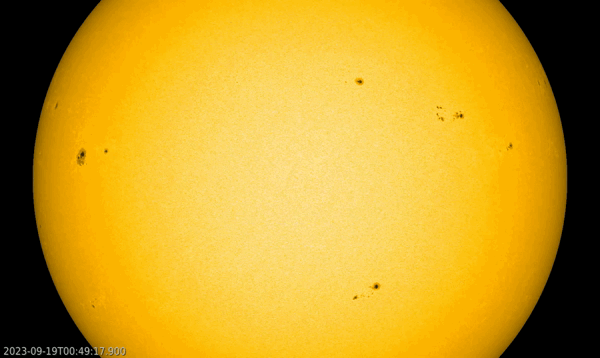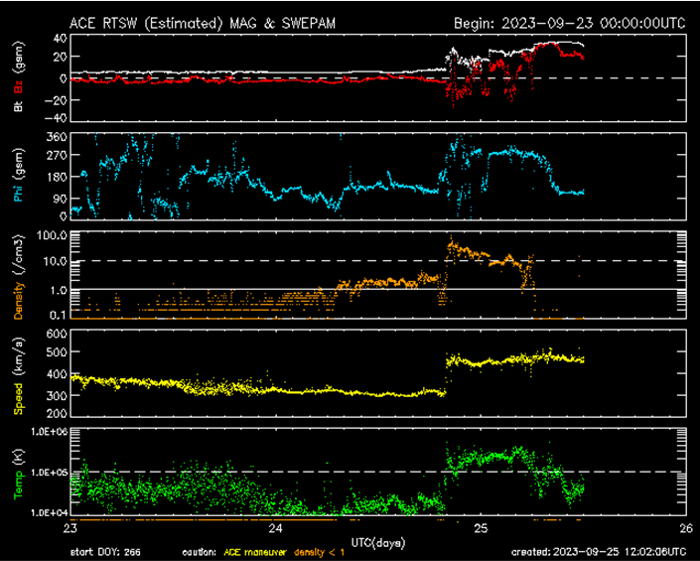The Sun was peppered with sunspots last week. About a dozen sunspot groups could be seen almost daily, and the estimated international sunspot number (SILSO) even exceeded 200 on 22 and 23 September. The most complex sunspot group was active region NOAA 3435 and stood out because of its compactness. The white light imagery (SDO/HMI) underneath shows the numerous freckles on the Sun. NOAA 3435 is the sunspot group in the eastern ("left") solar hemisphere near the solar equator.

The group developed a magnetic delta configuration from the 18th onwards. A sunspot group is said to contain a magnetic delta when it has at least one mature spot in which umbrae (the dark cores of a sunspot) of opposite magnetic polarities are separated by less than 2 degrees and situated within the common penumbra (the more greyish area surrounding the umbrae). Delta regions have a much higher flaring probability than the other regions. More information on the magnetic configuration of sunspot groups, as well as numerous examples can be found on the STCE's Space Weather classification page. This delta in NOAA 3435 developed south of the region's main spot, and gradually moved to the west ("right") during the next few days, gradually separating from the main spot and finally dissolving by late on 22 September. This can be seen in the SDO images underneath where a magnetogram is overlaid on a white light image. The clip covers the 19-22 September range, and the times of the compilation underneath correspond to the timing of the two most important flares produced by this region: an M8.2 event on 20 September at 14:19UTC, and an M8.7 flare on 21 September at 12:54UTC. Blue and red colors denote the opposite magnetic polarities (annotated image with the delta).




The two M-class flares can be seen in the compilation above (lower row) where an extreme ultraviolet (EUV) image (SDO/AIA 131) has been overlaid on a white light image. The blooming and diffraction patterns in the EUV images are image artefacts, not related to the flare - See this STCE newsitem for more info. The online clip covers 2 days (20-21 September), and the flashes of these M-class events show the relative brief duration of the flaring events, resp. 14 and 20 minutes. Nonetheless, these flares were associated with coronal mass ejections (CME), but only the one from 21 September was thought to have an earth-directed component. Sure enough, a shock was recorded in the solar wind parameters on 24 September around 20 UTC (ACE ; see image underneath). The shock can be clearly seen as a step-like structure in the solar wind density (orange curve), speed (yellow curve) and temperature (green). The intensity of the interplanetary magnetic field reached 34 nT (SIDC), with the north-south component Bz reaching a good -27 nT, one of the strongest so far this solar cycle. There is a possibility that there was some interaction with a faster CME from 22 September, but the jury is still out on this one. It might explain why the solar wind disturbance was somewhat stronger than expected.

However, the ensuing geomagnetic storm reached only 6- on the Kp-scale (NOAA), which is a moderate storm. Locally in Dourbes Belgium (K_BEL), the storm reached only minor storming levels, and the provisional Disturbance storm-time index got only -66 nT (Kyoto WDC). Compare that to the whopping -212 nT during the severe geomagnetic storm from last April, as described in the STCE newsitem! Despite the relatively weak storm, reports are pouring in that red aurora have been observed and photographed from the north of Belgium, the Netherlands, South-England and France (Burgundy). All observers mentioned the briefness and brightness of the event (only a few minutes), and not everybody was able to visually see the red hues (sources: https://www.spaceweather.com/ and HLN - https://www.hln.be/wetenschap-en-planeet/).





